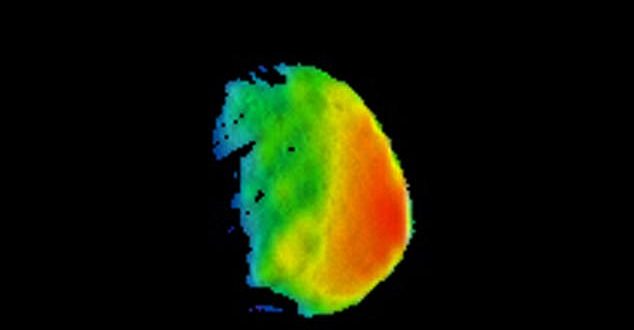The Thermal Emission Imaging System (THEMIS) camera on NASA’s Mars Odyssey spacecraft observed Phobos — the larger and inner of the two natural satellites of the Red Planet — on September 29, 2017.
THEMIS Principal Investigator Philip Christensen and THEMIS Mission Planner, Jonathon Hill of ASU’s School of Earth and Space Exploration, combined visible-wavelength and infrared data to produce an image color-coded for surface temperatures of this moon, which has been considered for a potential future human-mission outpost.
“Although THEMIS has been at Mars for 16 years, this was the first time we have been able to turn the spacecraft around to look at Phobos,” said Hill. “This half-moon view of Phobos was chosen because it allowed us to observe a wide range of temperatures on the surface.”
Looking across the image from left to right presents a sequence of times of day on the Martian moon, from before dawn, to sunrise, to increasing amounts of time after dawn. This provides information about how quickly the ground warms, which is related to the texture of the surface. As barefoot beach walks can confirm, sand warms or cools quicker than rocks or pavement.
“Including a predawn area in the observation is useful because all the heating from the previous day’s sunshine has reached its minimum there,” said THEMIS Deputy Principal Investigator Victoria Hamilton of Southwest Research Institute. “As you go from predawn area to morning area you get to watch the heating behavior. If it heats up very quickly, it’s likely not very rocky but dusty instead.”
Phobos has an oblong shape with an average diameter of about 14 miles (22 kilometers). Cameras on other Mars orbiters have previously taken higher-resolution images of Phobos, but none with the infrared information available from THEMIS. Observations in multiple bands of thermal-infrared wavelengths can yield information about the mineral composition of the surface, as well as the surface texture.
One major question about Phobos and Mars’ even smaller moon, Deimos, is whether they are captured asteroids or bits of Mars knocked into the sky by impacts. Compositional information from THEMIS might help pin down their origin.
Since Odyssey began orbiting the Red Planet in 2001, THEMIS has provided compositional and thermal-properties information from all over Mars, but never before imaged either Martian moon. The Sept. 29 observation was completed to validate that the spacecraft could safely do so, as the start of a possible series of observations of Phobos and Deimos in coming months.
In normal operating mode, Odyssey keeps the THEMIS camera pointed straight down as the spacecraft orbits Mars. In 2014, the spacecraft team at Lockheed Martin Space Systems, Denver; and NASA’s Jet Propulsion Laboratory, Pasadena, California; and the THEMIS team at ASU, developed procedures to rotate the spacecraft for upward-looking imaging of Comet Siding Spring as it passed near Mars. The teams have adapted those procedures for imaging the Martian moons.
“We now have the capability of rotating the spacecraft for THEMIS observations,” said Odyssey Project Scientist Jeffrey Plaut of JPL. “There is heightened interest in Phobos because of the possibility that future astronauts could perhaps use it as an outpost.”
With the first observation now in hand, plans are advancing for additional opportunities at different illumination phases of Phobos and Deimos.
“THEMIS has probably been the most interesting mission I’ve been a part of,” says Christensen. “We’ve learned a great deal about Mars, and it is very exciting to still be doing new and unique science 16 years after we got there.”
Agencies/Canadajournal
 Canada Journal – News of the World Articles and videos to bring you the biggest Canadian news stories from across the country every day
Canada Journal – News of the World Articles and videos to bring you the biggest Canadian news stories from across the country every day



